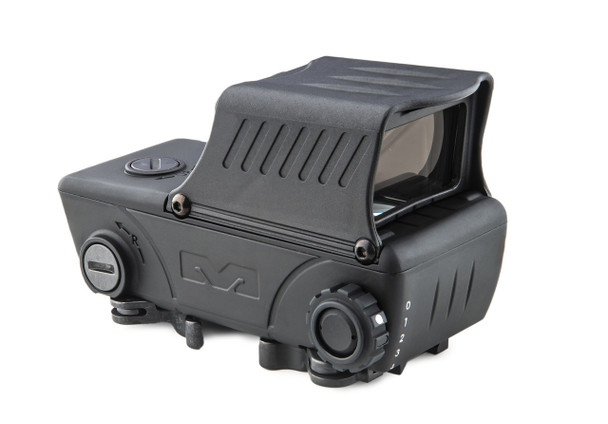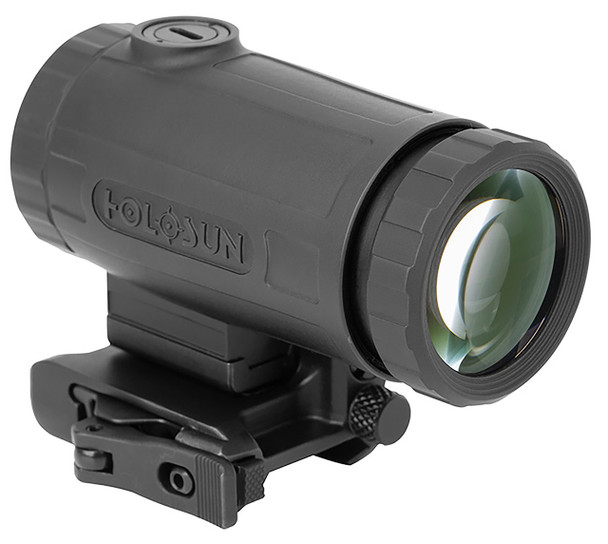How does a red dot sight work?
How does a red dot sight work?
Red dot sights are so wide-spread today that you may see one virtually anywhere, not only on a shooting range or during combat or law enforcement operations, but also in movies and computer games. The red dot itself became somewhat symbolic - often representing accuracy and high precision even in spheres not directly related to military or weapons altogether.
Historically, shooters always strived to aid aiming, but had virtually no technical means to do this. Their bare eyes were the only aiming device they had. Even with the assistance of simple crosshairs, the accuracy of shots depended much more on the talents of a shooter, than on the design or construction of the sight.
Things changed in the beginning of the 20th century. An optical engineer from Ireland, Howard Grubb invented and patented the first reflex sight in 1900. By that time there was little practical use for his invention, but during World War I optical reflex sights were mounted on selected aircrafts. Later, in World War II reflex sights were widely used not only on fighter aircrafts, but on small arms too.
The modern construction of a red dot sight was introduced nearly 50 years ago, in the 1970s.
The principle of operation of a red dot sight
So does a red dot sight work? Quite simply, in fact. The sight is a tube with a mounted semi-transparent concave lens. The image of the target comes to the tube and then goes effortlessly through the transparent side of the lens. The LED light installed in the sight at the same time projects a red dot image to the reflective side of the lens. The light reflects from the lens so that the illuminated projection of the red dot appears as being a part of the image of the target.
he image formed by the collimating lens uses parallel projection which means that the light beams coming from the LED becomes almost perfectly parallel. So the red dot projection in theory does not have any parallax, which is a great advantage of this type of optical sights. Really, regardless of how a shooter places his or her head against the sight, they always see the red dot directly on the target as long as the gun barrel points to it.
We’ll get to the advantages (and the disadvantages, of course) of red dot sights shortly.
Types of red dot sights
There are several types of red dot sights based on how the red dot is projected to the field of view:
- Reflex sights
- Holographic sights
- Prism sights
- Laser sights
Reflex sights
Reflex sights are the most common among red dots available on the market. They combine simplicity of design with excellent characteristics, almost lacking disadvantages. Reflector sights use a collimating lens (a reflector) to project light from an LED or a laser to the focal plane just as shown above.
Holographic sights
Holosights are the second best option. Unlike reflex red dot sights, holosight’s construction is based on a holographic reticle projected to the eye of a shooter. While the main principle remains the same, holograms have a distinctive advantage over other types of red dot sights: they are projected right in front of the sight. This means you don’t have to refocus your eye from the target to the reticle and back. Which in turn means faster image acquisition. In some situations this can make a huge difference.
Prismatic sights
Prism sights are essentially reflex sights but with a glass prism instead of lenses. However, prism scopes have a built-in magnification, so you basically get two in one. Also, they do not need a battery to function and are better for people with astigmatism.
Laser sights
Finally, there are laser sights that do not rely on any optical system, but rather use the laser itself to aid target acquisition. A laser sight projects a beam of light to the target giving a visible reference point to a shooter. Sure enough, such red dots are visible not only for a sight user, but for anyone else too unless an IR sight is used.
Advantages and disadvantages of red dot sights
Speaking of pros and cons, you should always keep in mind the construction of the red dot sight in question, because while say holosights and reflex sights are practically both red dot sights, they are very different in how they function.
Reflex red dot sights pros and cons
Advantages of reflex sights are well-known today: they are lightweight, compact and can be installed even onto a NERF gun. Reflex sights also feature the broadest field of view and allow aiming with both eyes open. Thanks to almost zero parallax at longer distances, reflex red dots allow for precision aiming in virtually no time. So if your duty involves fast shooting with as quick aiming as possible, reflex sights should be your choice.
On the downside, they are not as effective at ranges where parallax shift becomes significant. Yes, we said above that there are no parallax, but in reality any real target image comes from a certain distance, not from infinity. Sometimes a red dot sight may allow you to fine-tune the range, though.
As for long ranges, the parallax is neglectable, but another issue enters the picture. You see, the reticle image itself can overlap a significant part of the target making it harder to aim precisely. The trouble gets even worse if you use magnification.
Holographic red dot sight pros and cons
Holosights project a hologram so that it appears as drawn over the image of the target. This means you don’t need to refocus your eye, so you can acquire the target faster. That’s good. The bad thing is: there are a lot of lenses and mirrors in the holosight, so the entire device is bulkier and heavier. This means many holosight models cannot be installed on pistols.
Holographic red dot sights are pricey too. But since you can acquire the target faster with a holosight, this disadvantage can be easily compensated by improved performance.
Other advantages of holosight are zero parallax, and excellent performance with magnifiers. And finally, unlike reflex sights, holographic sights remain functional even if the main glass of the sight is partially damaged or covered with dirt.
Laser red dot sight pros and cons
As for laser sights, they are somewhat unique in their combination of advantages and drawbacks. For one, laser sights do not have any optical system save for the laser itself. This allows you to aim in almost any situation, without any specific placement of your head and without even looking through the sight. Then, laser red dot sights make a perfect combination with magnifiers - you just look through the scope and see the magnified target image with the red dot from the laser over it.
There are drawbacks of laser red dot sights too. One is visibility of the dot. Here, the red dot is not just an optical reticle; this is a real dot on the target. This could pose a problem if you planned a covert operation. Another minus is also related to visibility: the laser dot can become barely visible on the bright day light rendering your aiming capability to almost zero. A significant drawback of laser sight is accuracy at long range: the laser beam itself follows an ideally straight line, but a bullet doesn’t. The trajectory of a bullet is parabolic and is also subject to wind and other effects.
What to look at when choosing a red dot sight
So, now as you know how red dot sights work, what red dot sight is the best? There is not universal answer to this question. Reflex sights are affordable and simple, but have their cons. Holosights offer the fastest target acquisition and the clearest sight, but are expensive and somewhat bulky. All in all, the final choice depends on your goals and purposes, as well as on what particular model and mark of the red dot sight you buy.
However, overall there are several vital points you should pay attention to when selecting a red dot sight.
Weight
The weight of a red dot sight means a lot during prolonged missions or dynamic shooting. Every single gram above that of the weapon can hinder your combat performance. Pistols typically should rely mostly on simple reflex red dot sights, because they are the lightest and most affordable too.
Adjustable brightness of the reticle
Seemingly a minor function, adjustable brightness is in fact a real helper. In the daylight you can increase it for better visibility and easier aiming. And during dark time you better set lower brightness to avoid excessive strain to your eyes.
MOA
MOA stands for Minutes of Arc (or Minutes of Angle). This is a standard measure of the reticle size. Bigger size of a red dot reticle means simpler aiming. On the other hand, high MOA values mean the reticle image obscures targets that look smaller than this value. Typically, if your targets are primarily at short to medium distances you should look for MOA 4 to 10. Distant targets require smaller reticle size, such as 3 MOA. And just with brightness, adjustable MOA is the best option.
Overall adjustability
For proper aiming you need to consider elevation and wind, so you need to set a proper zero for your red dot sight. You may also want to attach the sight to your specific weapon model, so make sure the product of your choice fits your hand arm.
Battery life
Reflex sights are more energy saving in comparison with holographic sights. On average, holosights can work on a single CR2032 battery for 500-800 hours, while a reflex red dot sight can operate on a single tablet literally for years.
Tubed design vs. open design
The size of a red dot sight also matters. Reflex red dot sights are more compact and lightweight even in the tubed design. And the open design is extremely compact so they fit even the smallest firearms.
Reticle color
Despite the name, red dot sights can produce reticles of different colors. And while the typical and most often selected color is still red, some shooters prefer green color of the reticle, because it partially reduces the eye strain, this can be important in longer shooting sessions.
In conclusion
Red dot sights are one of the most popular addons to firearms, and they are available to anyone. There are no legal restrictions in the U.S. neither on buying red dot sights, nor on using them. Their simple and reliable principle of operation also makes them very affordable and lightweight. However, you must clearly understand what you will be using the red dot sight for. Depending on your goals and purposes you may prefer one or another design of a red dot sight, and there is no one ultimate solution equally suitable for every type of activity.
BattleSteel®️ has been selling weapon systems for years. So if you need further consultation on how red dot sight work, and which one you can mount on your firearm, please don’t hesitate to contact us.
Recent Posts
-
Understanding Ballistic Shield Ratings and Their Applications
The Trusted Name in Tactical Defense - BattleSteel® When it comes to protecting those who protec …2025-04-19 -
The Importance of Hearing Protection in Tactical Environments
The Legacy of BattleSteel® BattleSteel® is a trusted name in the world of tactical defense e …2025-04-14 -
How to Properly Fit and Wear a Plate Carrier
About BattleSteel and Their Mission BattleSteel is a trusted name in the tactical gear industry, ren …2025-04-11





